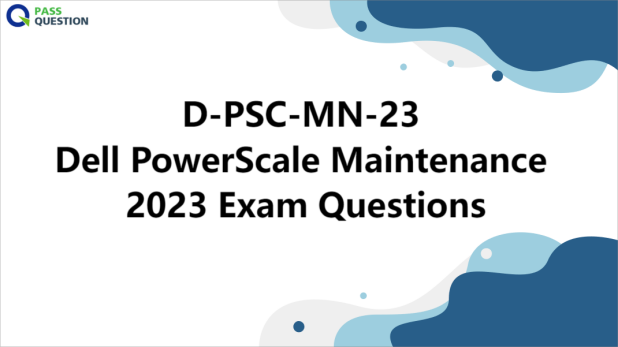
Dell PowerScale Maintenance 2023 Exam
Suppose you are facing any trouble while preparing for D-PSC-MN-23 Dell PowerScale Maintenance 2023 Exam. In that case, you can study the latest D-PSC-MN-23 Dell PowerScale Maintenance 2023 Exam Questions from PassQuestions to help you prepare for the real exam. The main objective of these D-PSC-MN-23 exam questions is to help you build confidence in your abilities to excel in the exam. By practicing these D-PSC-MN-23 Dell PowerScale Maintenance 2023 Exam Questions, you can familiarize yourself with the exam format and the types of questions you will encounter in the actual D-PSC-MN-23 exam. This exposure and practice will, in turn, ensure that you are well-prepared and poised to pass your D-PSC-MN-23 exam with ease.

The examination is concentrated on the principles and processes necessary for installing, setting up, and preserving the hardware in a PowerScale system. The topics discussed include installation and initial setup procedures, Field Replaceable Units (FRUs), Customer Replaceable Units (CRUs), and maintenance procedures applicable to all PowerScale hardware lines. This certification attests to the candidate's understanding of PowerScale product installation, cabling, and maintenance, including its components. The Dell PowerScale Maintenance 2023 Exam is 90 minutes long and made up of 50 questions. To successfully pass the exam, a minimum score of 63% is needed.
Exam Topics
Topics likely to be covered on this exam include:
PowerScale Hardware Concepts (24%)
• Describe the methods, tools, and related considerations required for an installation, for example: phases, SolVe
• Describe the design and capabilities of PowerScale Gen 6 and Gen 6.5 nodes
• Describe internal and external networking requirements and setup
• Describe the nature and use of cluster management tools, for example: WebUI, CLI, Serial Console, PAPI
PowerScale Hardware Maintenance (24%)
• Describe preliminary tasks required for hardware maintenance
• Describe tasks required to prepare a node for operation
• Describe how to install and maintain key FRUs
• Describe how to install and maintain key CRUs
PowerScale Hardware Installation (24%)
• Planning the installation
• Describe actions required to prepare the site
• Describe requirements and steps for installing the rack and subcomponents
• Describe how to cable nodes correctly
PowerScale Implementation (28%)
• Describe how to create a new cluster
• Describe the process for joining node to a cluster, including smartfailing, reformatting, reimaging
• Describe tools and methods used to complete a configuration, focusing on compliance, SRS, and Hadoop
• Describe tools and procedures used for handling upgrades, versioning, and patches
View Online Dell PowerScale Maintenance 2023 D-PSC-MN-23 Free Questions
1. In the context of PowerScale, what is the primary function of the PAPI tool?
A. To provide physical console access
B. To enable programmatic cluster management
C. To facilitate network configuration
D. To assist in hardware diagnostics
Answer: B
2. Which of the following tasks is crucial when installing a new FRU in a PowerScale node?
A. Configuring network settings
B. Validating the compatibility of the FRU with the node
C. Assigning a static IP address to the FRU
D. Creating a backup of the node's configuration
Answer: B
3. What is a recommended practice when maintaining CRUs in a PowerScale node?
A. Regularly rotating CRUs between nodes to ensure even wear
B. Keeping a log of all CRU maintenance activities
C. Testing CRUs in a separate environment before installation
D. Using only proprietary tools for CRU installation and removal
Answer: B
4. What is the first step in planning the installation of a PowerScale cluster?
A. Determining the optimal operating system version
B. Calculating the total power consumption
C. Designing the network topology
D. Assessing the physical environment for suitability
Answer: D
5. How do you ensure data continuity during a PowerScale node hardware upgrade?
A. Implement rolling upgrades across the cluster
B. Synchronize all nodes before starting the upgrade
C. Use data mirroring to an external backup cluster
D. Isolate the node being upgraded from the network
Answer: A
6. What are the essential phases in the PowerScale installation process?
A. Planning and sizing
B. Networking and configuration
C. Data migration
D. Validation and testing
Answer: ABD
7. What are key considerations when designing the networking architecture for a PowerScale cluster? (Select two)
A. Network latency
B. Firewall configurations
C. Switch capacity
D. Subnet planning
Answer: AC
8. When preparing a site for PowerScale installation, which of the following considerations are crucial? (Select two)
A. Verifying environmental controls are within recommended parameters
B. Ensuring that the flooring is anti-static
C. Preparing an emergency evacuation plan specific to the data center
D. Confirming that data center staff are trained on PowerScale hardware
Answer: AB
9. What is the best practice for managing versioning and patches in a PowerScale cluster?
A. Regularly reviewing available updates for compatibility
B. Applying patches during off-peak hours to minimize impact
C. Testing updates in a non-production environment
D. Maintaining a consistent patch level across all nodes
Answer: D
10. What is a fundamental step in creating a new PowerScale cluster?
A. Selecting a cluster name and assigning it an IP range
B. Installing anti-virus software on all nodes
C. Configuring email alerts for system warnings
D. Subscribing to a support plan for hardware replacement
Answer: A
Related Courses and Certification
Also Online IT Certification Courses & Online Technical Certificate Programs

